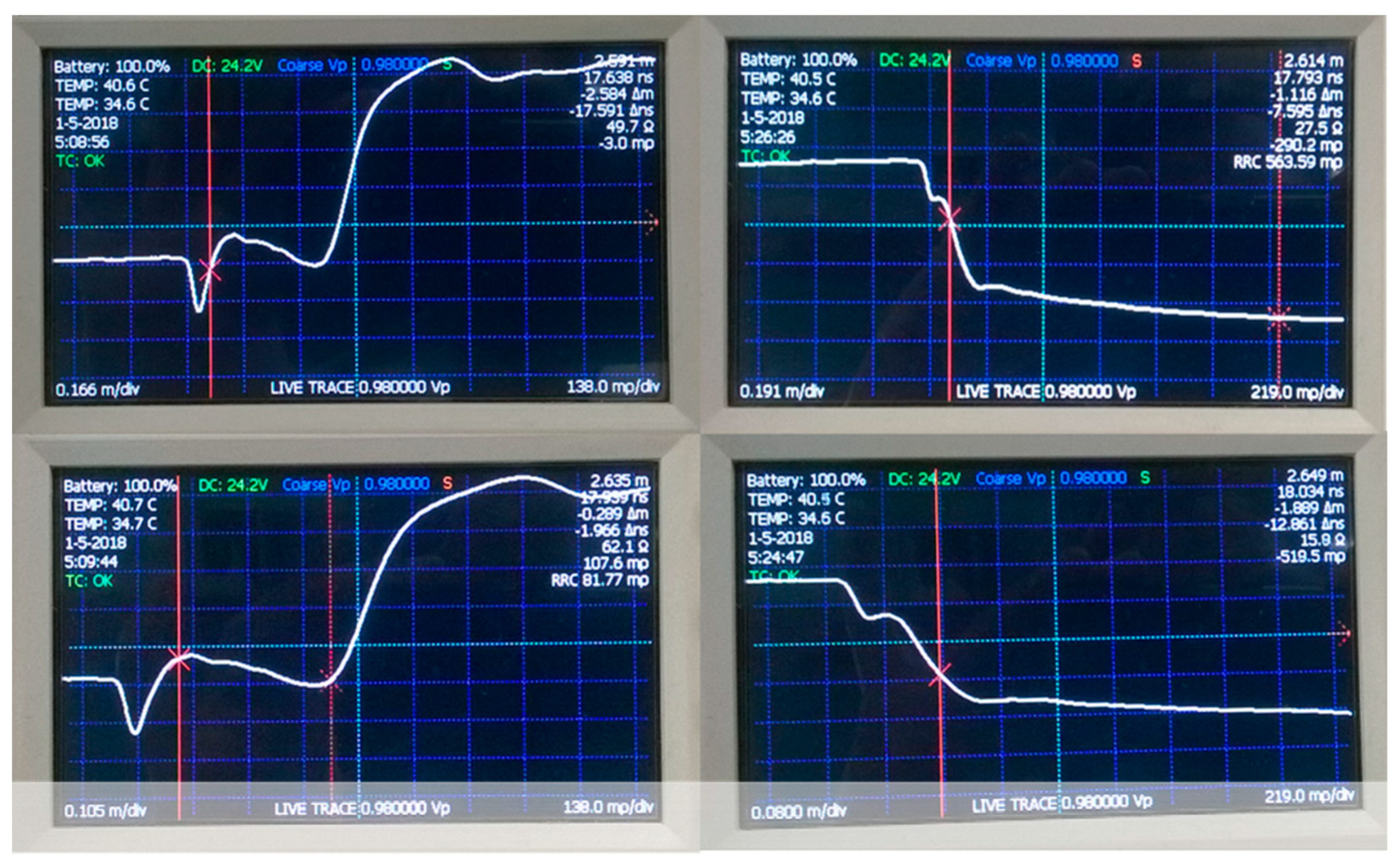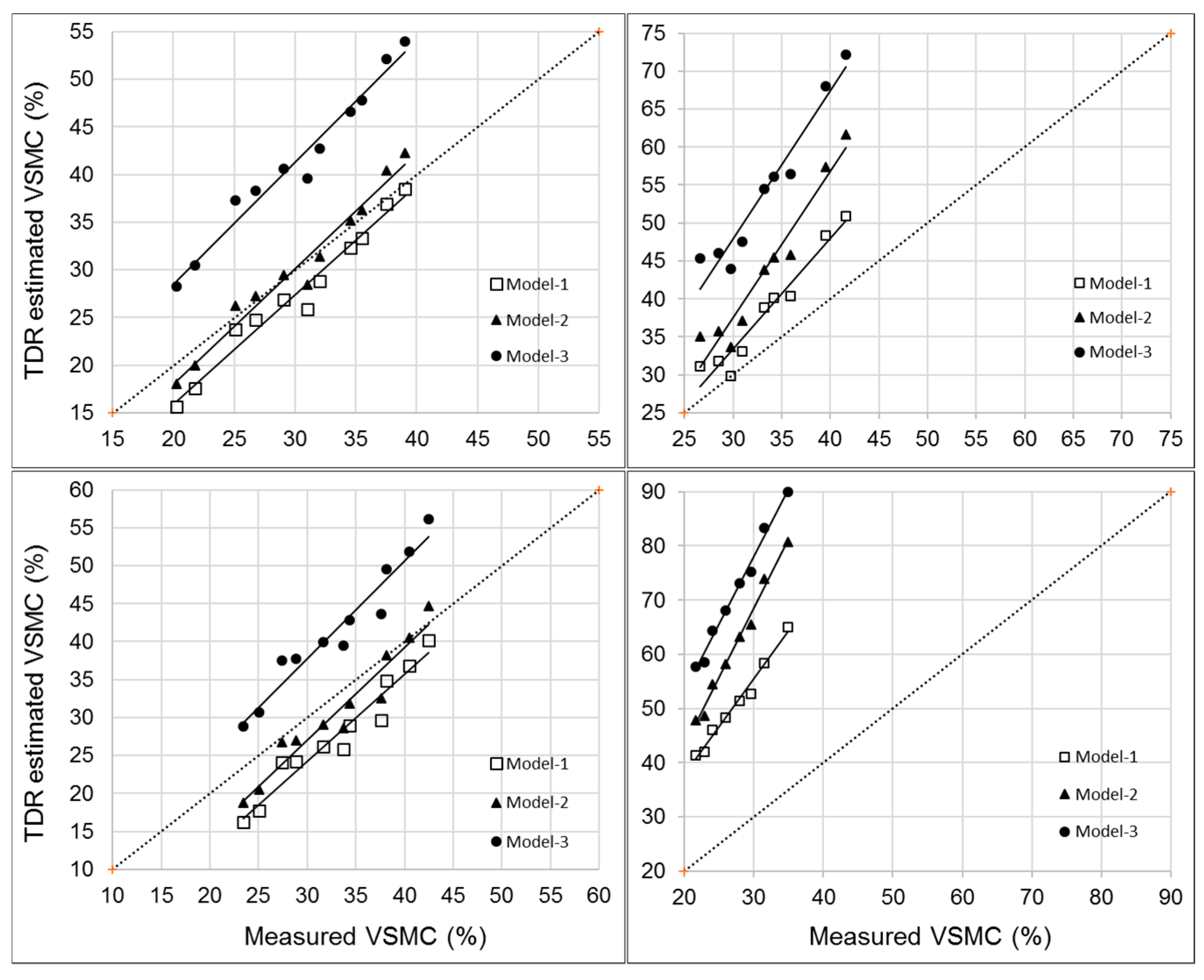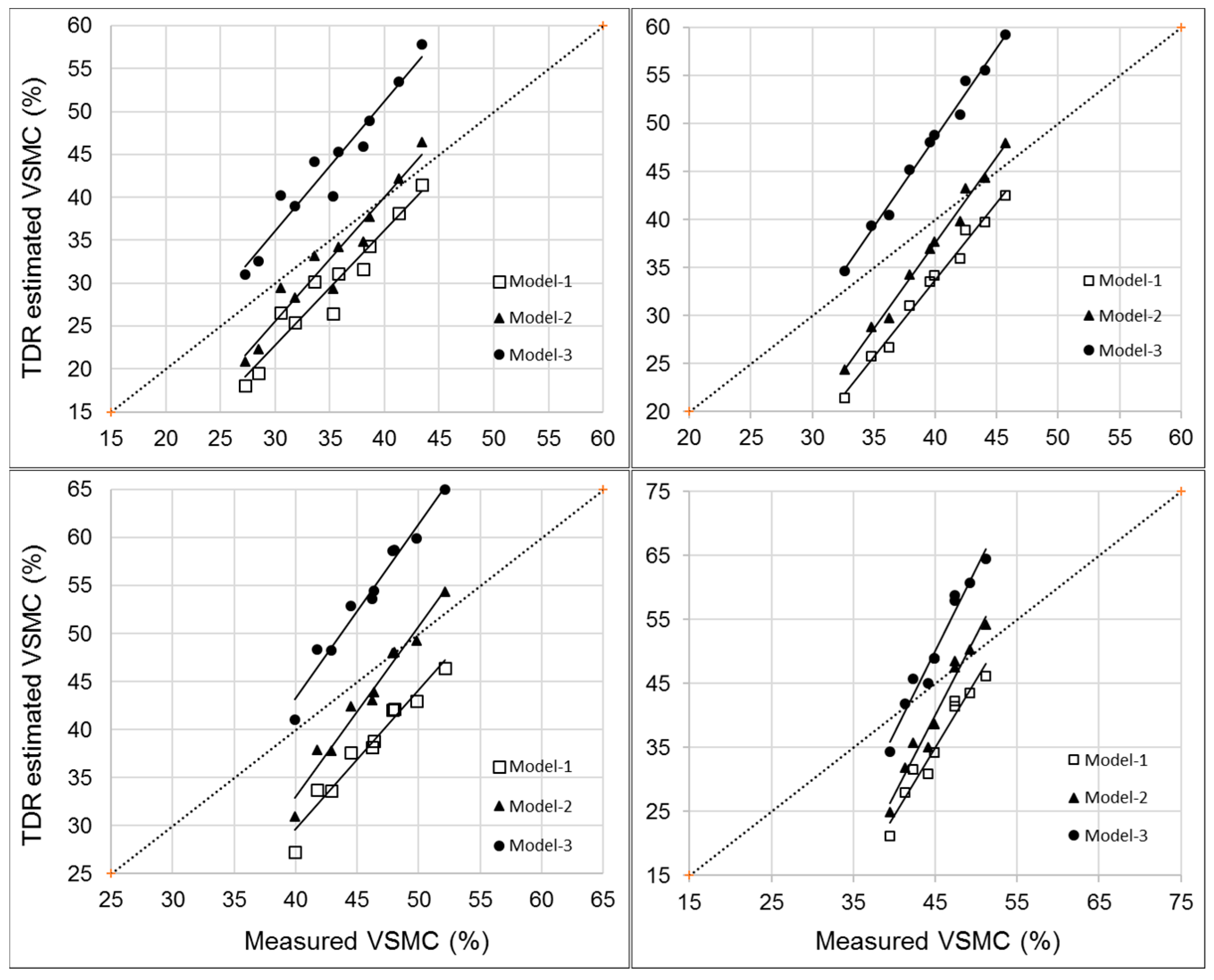Effect of Biochar on TDR-Based Volumetric Soil Moisture Measurements in a Loamy Sand Podzolic Soil
Abstract
1. Introduction
2. Materials and Methods
2.1. Soil
2.2. Preparation of BC: Soil Mixtures
2.3. Estimation of Volumetric Soil Moisture Content Using Kb
2.4. Measurements of Volumetric Soil Moisture Content
2.5. Statistical Analysis
3. Results and Discussion
3.1. Effects of BC on TDR Measurement
3.2. Evaluation of Three Models Based on Estimated VSMC
4. Conclusions
Author Contributions
Funding
Acknowledgments
Conflicts of Interest
References
- Nagare, R.; Schincariol, R.; Quinton, W.; Hayashi, M. Laboratory calibration of time domain reflectometry to determine moisture content in undisturbed peat samples. Eur. J. Soil. Sci. 2011, 62, 505–515. [Google Scholar] [CrossRef]
- Baker, J.; Allmaras, R. System for automating and multiplexing soil moisture measurement by time domain reflectometry. Soil Sci. Soc. Am. J. 1990, 54, 1–6. [Google Scholar] [CrossRef]
- Topp, C.; Davis, L.; Annan, P. Electromagnetic determination of soil water content using TDR: I. Applications to wetting fronts and steep gradients. Soil Sci. Soc. Am. J. 1982, 46, 672–678. [Google Scholar] [CrossRef]
- Jackson, N.; Wallace, J. Analysis of soil water dynamics in an agroforestry system based on detailed soil water records from time domain reflectometry. Hydrol. Earth Syst. Sci. 1999, 3, 517–527. [Google Scholar] [CrossRef]
- Moret, D.; Lopez, M.; Arrúe, J. TDR application for automated water level measurement from Mariotte reservoirs in tension disc infiltrometers. J. Hydrol. 2004, 297, 229–235. [Google Scholar] [CrossRef]
- Overduin, P.; Kane, D. Frost boils and soil ice content: Field observations. Permafr. Periglac. 2006, 17, 291–307. [Google Scholar] [CrossRef]
- Gaur, A.; Hortona, R.; Jaynes, B.; Lee, J.; Al-Jabrid, S. Using surface time domain reflectometry measurements to estimate subsurface chemical movement. Vadose Zone J. 2003, 2, 539–543. [Google Scholar] [CrossRef][Green Version]
- Topp, C.; Davis, L.; Annan, P. Electromagnetic determination of soil water content: Measurement in coaxial transmission lines. Water Resour. Res. 1980, 16, 574–582. [Google Scholar] [CrossRef]
- Cassel, D.; Kachanoski, G.; Topp, C. Practical considerations for using a TDR cable tester. Soil Technol. 1994, 7, 113–126. [Google Scholar] [CrossRef]
- Jones, S.; Wraith, J.; Or, D. Time domain reflectometry measurement principles and applications. Hydrol. Process. 2002, 16, 141–153. [Google Scholar] [CrossRef]
- Yu, X.; Yu, X. Time Domain Reflectometry Tests of Multilayered Soils. Proceedings of TDR 2006, Paper ID 3; Purdue University: West Lafayette, IN, USA, 2006; p. 16. [Google Scholar]
- Gao, Q.; Yu, X. Design and evaluation of a high sensitivity spiral TDR scour sensor. Smart Mater. Struct. 2015, 24, 085005. [Google Scholar] [CrossRef]
- Gasvoda, D. Campbell Water Content Reflectometer: Evaluation in Compacted Road Soils; USDA-Forest Service: Missoula, MT, USA, 1998. [Google Scholar]
- Ferre, A.; Knight, H.; Rudolph, D.; Kachanoski, G. The sample areas of conventional and alternative Time Domain Reflectometry probes. Water Resour. Res. 1998, 34, 2971–2979. [Google Scholar] [CrossRef]
- Dobson, C.; Ulaby, T.; Hallikainen, T.; El-Rayes, A. Microwave dielectric behavior of wet soil—Part II: Dielectric mixing models. IEEE Trans. Geosci. Remote Sens. 1985, 1, 35–46. [Google Scholar] [CrossRef]
- Roth, K.; Schulin, R.; Fluhler, H.; Attinger, W. Calibration of time domain reflectometry for water content measurement using a composite dielectric approach. Water Resour. Res. 1990, 26, 2267–2273. [Google Scholar] [CrossRef]
- Schaap, M.; De Lange, L.; Heimovaara, T. TDR calibration of organic forest floor media. Soil Technol. 1996, 11, 205–217. [Google Scholar] [CrossRef]
- Drnevich, P.; Siddiqui, I.; Lovell, J.; Yi, Q. Water Content and Density of Soil In-Situ by the Purdue TDR Method; Purdue University: West Lafayette, IN, USA, 2001. [Google Scholar]
- Kaiser, D.; Reinert, D.; Reichert, J.; Minella, J. Dielectric constant obtained from TDR and volumetric moisture of soils in southern Brazil. Rev. Bras. Ciênc. Solo. 2010, 34, 649–658. [Google Scholar] [CrossRef]
- Teixeira, W.; Schroth, G.; Marques, J.; Huwe, B. Sampling and TDR probe insertion in the determination of the volumetric soil water. Rev. Bras. Ciênc. Solo. 2003, 27, 575–582. [Google Scholar] [CrossRef]
- Pepin, M.C.; Pothier, F.; Barden, N. Impaired type II glucocorticoid-receptor function in mice bearing antisense RNA transgene. Nature 1992, 355, 725–728. [Google Scholar] [CrossRef]
- Kellner, E.; Lundin, L.-C. Calibration of time domain reflectometry for water content in peat soil. Hydrol. Res. 2001, 32, 315–332. [Google Scholar] [CrossRef]
- Yoshikawa, K.; Overduin, P.; Harden, W. Moisture content measurements of moss (Sphagnum spp.) using commercial sensors. Permafr. Periglac. 2004, 15, 309–318. [Google Scholar] [CrossRef]
- Pumpanen, J.; Ilvesniemi, H. Calibration of time domain reflectometry for forest soil humus layers. Boreal Environ. Res. 2005, 10, 589–595. [Google Scholar]
- Dettmann, U.; Bechtold, M. Evaluating commercial moisture probes in reference solutions covering mineral to peat soil conditions. Vadose Zone J. 2018, 17, 170208. [Google Scholar] [CrossRef]
- Lopez, V. Biochar as a Soil Amendment: Impact on Hydraulic and Physical Properties of an Arable Loamy Sand Soil. Master’s Thesis, University of California, Merced, CA, USA, 2014. [Google Scholar]
- Chan, Y.; Van Zwieten, L.; Meszaros, I.; Adriana, D.; Joseph, S. Agronomic values of greenwaste biochar as a soil amendment. Aust. J. Soil Res. 2007, 45, 629–634. [Google Scholar] [CrossRef]
- Novak, J.; Busscher, W.; Watts, D.; Amonette, J.; Ippolito, J.; Lima, I.; Gaskin, J.; Steiner, S.; Ahmedna, M.; Rehrah, D.; et al. Biochars impact on soil-moisture storage in an Ultisol. Soil Sci. 2012, 177, 310–320. [Google Scholar] [CrossRef]
- Abel, S.; Peters, A.; Trinks, S.; Schonsky, H.; Facklam, M.; Wessolek, G. Impact of biochar and hydrochar addition on water retention and water repellency of sandy soil. Geoderma 2013, 202, 183–191. [Google Scholar] [CrossRef]
- Mukherjee, A.; Lal, R. Biochar impacts on soil physical properties and greenhouse gas emissions. Agronomy 2013, 3, 313–339. [Google Scholar] [CrossRef]
- Lehmann, J.; Czimczik, C.; Laird, D.; Sohi, S. Stability of biochar in soil. In Biochar for Environmental Management: Science and Technology; Lehmann, J., Joseph, S., Eds.; Earthscan: London, UK, 2009; pp. 183–205. [Google Scholar]
- Kameyama, K.; Miyamoto, T.; Shiono, T.; Shinogi, Y. Influence of sugarcane bagasse-derived biochar application on nitrate leaching in calcaric dark red soil. J. Environ. Qual. 2012, 41, 1131–1137. [Google Scholar] [CrossRef] [PubMed]
- Kinney, T.; Masiello, C.; Dugan, B.; Hockaday, W.; Dean, M.; Zygourakis, K.; Barnes, R. Hydrological properties of biochars produced at different temperatures. Biomass Bioenergy 2012, 41, 34–43. [Google Scholar] [CrossRef]
- Kameyama, K.; Miyamoto, T.; Shiono, T. Influence of biochar incorporation on TDR-based soil water content measurements. Eur. J. Soil Sci. 2014, 65, 105–112. [Google Scholar] [CrossRef]
- Badewa, E.; Unc, A.; Cheema, M.; Kavanagh, V.; Galagedara, L. Moisture mapping using multi-frequency and multi-coil electromagnetic induction sensors on managed podzols. Agronomy 2018, 8, 224. [Google Scholar] [CrossRef]
- Jeffery, S.; Verheijen, F.; Van Der Velde, M.; Bastos, A. A quantitative review of the effects of biochar application to soils on crop productivity using meta-analysis. Agric. Ecosyst. Environ. 2011, 144, 175–187. [Google Scholar] [CrossRef]
- Schulz, H.; Dunst, G.; Glaser, B. Positive effects of composted biochar on plant growth and soil fertility. Agron. Sustain. Dev. 2013, 33, 817–827. [Google Scholar] [CrossRef]
- Kaudal, B.; Chen, D.; Madhavan, D.; Downie, A.; Weatherley, A. An examination of physical and chemical properties of urban biochar for use as growing media substrate. Biomass Bioenergy 2016, 84, 49–58. [Google Scholar] [CrossRef]
- Margenot, A.; Griffin, D.; Alves, B.; Rippner, D.; Li, C.; Parikh, S. Substitution of peat moss with softwood biochar for soil-free marigold growth. Ind. Crop. Prod. 2018, 112, 160–169. [Google Scholar] [CrossRef]
- Adams, W. The effect of organic matter on the bulk and true densities of some uncultivated podzolic soils. Eur. J. Soil. Sci. 1973, 24, 11–17. [Google Scholar] [CrossRef]
- Jones, S.; Or, D. Surface area, geometrical and configurational effects on permittivity of porous media. J. Non Cryst. Solids 2002, 305, 247–254. [Google Scholar] [CrossRef]
- Birchak, J.; Gardner, D.; Hipp, J.; Victor, J. High dielectric constant microwave probes for sensing soil moisture. Proc. IEEE 1974, 62, 93–98. [Google Scholar] [CrossRef]
- Friedman, P. A saturation degree-dependent composite spheres. Water Resour. Res. 1998, 34, 2949–2961. [Google Scholar] [CrossRef]
- Oleszczuk, P.; Baran, S.; Baranowska, E. Influence of long-term soils flooding by distilled and post-sewage water on Polycyclic Aromatic Hydrocarbons (PAHs) changes. Water Air Soil Pollut. 2007, 180, 237–248. [Google Scholar] [CrossRef]
- Bridge, B.; Sabburg, J.; Habash, K.; Ball, J.; Hancock, N. The dielectric behaviour of clay soils and its application to time domain reflectometry. Aust. J. Soil Res. 1996, 34, 825–835. [Google Scholar] [CrossRef]
- Wyseure, L.; Mojid, A.; Malik, A. Measurement of volumetric water content by TDR in saline soils. Eur. J. Soil Sci. 1997, 48, 347–354. [Google Scholar] [CrossRef]
- Bittelli, M.; Salvatorellii, F.; Pisa, P. Correction of TDR based soil water content measurements in conductive soils. Geoderma 2008, 143, 133–142. [Google Scholar] [CrossRef]
- Hook, R.; Ferré, T.; Livingston, J. The effects of salinity on the accuracy and uncertainty of water content measurement. Soil Sci. Soc. Am. J. 2004, 68, 47–56. [Google Scholar] [CrossRef]
- Robinson, D.; Bell, J.; Batchelor, C. Influence of iron minerals on the determination of soil water content using dielectric techniques. J. Hydrol. 1994, 161, 169–180. [Google Scholar] [CrossRef]
- Chen, R.; Chen, Y.; Chen, W.; Chen, Y. Time domain reflectometry for water content measurement of municipal solid waste. Environ. Eng. Sci. 2012, 29, 486–493. [Google Scholar] [CrossRef]
- Miyamoto, T.; Chikushi, J. Time domain reflectometry calibration for typical upland soils in Kyushu, Japan. Jpn. Agric. Res. Q. 2006, 40, 225–231. [Google Scholar] [CrossRef][Green Version]
- Wesenbeeck, J.; Kachanoski, G. Spatial and temporal distribution of soil water in the tilled layer under a corn crop. Soil Sci. Soc. Am. J. 1988, 52, 363–368. [Google Scholar] [CrossRef]
- Gihlar, J.; Ulaby, F.T. Dielectric Properties of Soils as a Function of Moisture Content; The University of Kansas: Lawrence, KS, USA, 1974; pp. 1–68. [Google Scholar]




| Property | Unit | Powdered # | Granular $ |
|---|---|---|---|
| Feedstock | Mix softwood | Yellow pine wood (Pinus taeda) | |
| Pyrolysis Temperature | °C | 450–500 | 500 |
| Duration | min | 30 | 30 |
| Particle size | mm | <0.5 | 1–6 |
| Bulk density | (g cm−3) | 0.75 | 0.20 |
| Moisture content | (%) | 5.0 | 15.2 |
| pH (1:10 BC:water) | 8.9 | 9.0 | |
| ECa at 21–22 °C | (dS m−1) | 1.3 | 5.2 |
| Fixed carbon | % | 69 | 87.3 |
| Volatile carbon (600 °C) | % | 22 | 12.7 |
| Ash content | % | 4.0 | 6.0 |
| BC Rate (%) | 0 | 5 | 10 | 15 | 20 | 40 | 50 | 100 |
|---|---|---|---|---|---|---|---|---|
| BDP (g cm−3) | 1.25 | 1.21 | 1.17 | 1.14 | 1.10 | 0.99 | 0.94 | 0.75 |
| BDG (g cm−3) | 1.25 | 0.99 | 0.82 | 0.70 | 0.61 | 0.40 | 0.34 | 0.20 |
| BC Rate (%) | VSMCP | VSMCG | ||||
|---|---|---|---|---|---|---|
| Min | Max | Avg | Min | Max | Avg | |
| 0 | 17.4 | 32.9 | 25.6 | 17.4 | 32.9 | 25.6 |
| 1 | 20.8 | 38.4 | 30.0 | 25.1 | 39.6 | 31.3 |
| 5 | 20.2 | 39.0 | 30.2 | 26.6 | 41.6 | 33.3 |
| 10 | 23.4 | 42.5 | 33.0 | 21.6 | 34.9 | 27.3 |
| 15 | 27.3 | 43.4 | 34.9 | 14.4 | 22.5 | 18.1 |
| 20 | 32.6 | 45.7 | 39.5 | n/a | n/a | n/a |
| 30 | 30.9 | 45.0 | 38.6 | n/a | n/a | n/a |
| 40 | 40.0 | 52.1 | 45.9 | n/a | n/a | n/a |
| 50 | 39.5 | 51.2 | 45.2 | n/a | n/a | n/a |
| 100 | 53.6 | 64.2 | 59.2 | n/a | n/a | n/a |
| BC (%) | M-1 | M-2 | M-3 | |||
|---|---|---|---|---|---|---|
| Reg. Eq. | R2 | Reg. Eq. | R2 | Reg. Eq. | R2 | |
| 0 | 0.91 | 0.91 | 0.91 | |||
| 5 | 0.96 | 0.96 | 0.96 | |||
| 10 | 0.96 | 0.96 | 0.96 | |||
| 15 | 0.92 | 0.92 | 0.92 | |||
| 20 | 0.99 | 0.98 | 0.98 | |||
| 40 | 0.96 | 0.97 | 0.97 | |||
| 50 | 0.96 | 0.96 | 0.96 | |||
| 100 | 0.95 | 0.95 | 0.95 | |||
| BC (%) | M-1 | M-2 | M-3 | |||
|---|---|---|---|---|---|---|
| Reg. Eq. | R2 | Reg. Eq. | R2 | Reg. Eq. | R2 | |
| 0 | 0.91 | 0.91 | 0.91 | |||
| 5 | 0.93 | 0.92 | 0.92 | |||
| 10 | 0.88 | 0.99 | 0.99 | |||
© 2019 by the authors. Licensee MDPI, Basel, Switzerland. This article is an open access article distributed under the terms and conditions of the Creative Commons Attribution (CC BY) license (http://creativecommons.org/licenses/by/4.0/).
Share and Cite
Wanniarachchi, D.; Cheema, M.; Thomas, R.; Galagedara, L. Effect of Biochar on TDR-Based Volumetric Soil Moisture Measurements in a Loamy Sand Podzolic Soil. Soil Syst. 2019, 3, 49. https://doi.org/10.3390/soilsystems3030049
Wanniarachchi D, Cheema M, Thomas R, Galagedara L. Effect of Biochar on TDR-Based Volumetric Soil Moisture Measurements in a Loamy Sand Podzolic Soil. Soil Systems. 2019; 3(3):49. https://doi.org/10.3390/soilsystems3030049
Chicago/Turabian StyleWanniarachchi, Dinushika, Mumtaz Cheema, Raymond Thomas, and Lakshman Galagedara. 2019. "Effect of Biochar on TDR-Based Volumetric Soil Moisture Measurements in a Loamy Sand Podzolic Soil" Soil Systems 3, no. 3: 49. https://doi.org/10.3390/soilsystems3030049
APA StyleWanniarachchi, D., Cheema, M., Thomas, R., & Galagedara, L. (2019). Effect of Biochar on TDR-Based Volumetric Soil Moisture Measurements in a Loamy Sand Podzolic Soil. Soil Systems, 3(3), 49. https://doi.org/10.3390/soilsystems3030049






